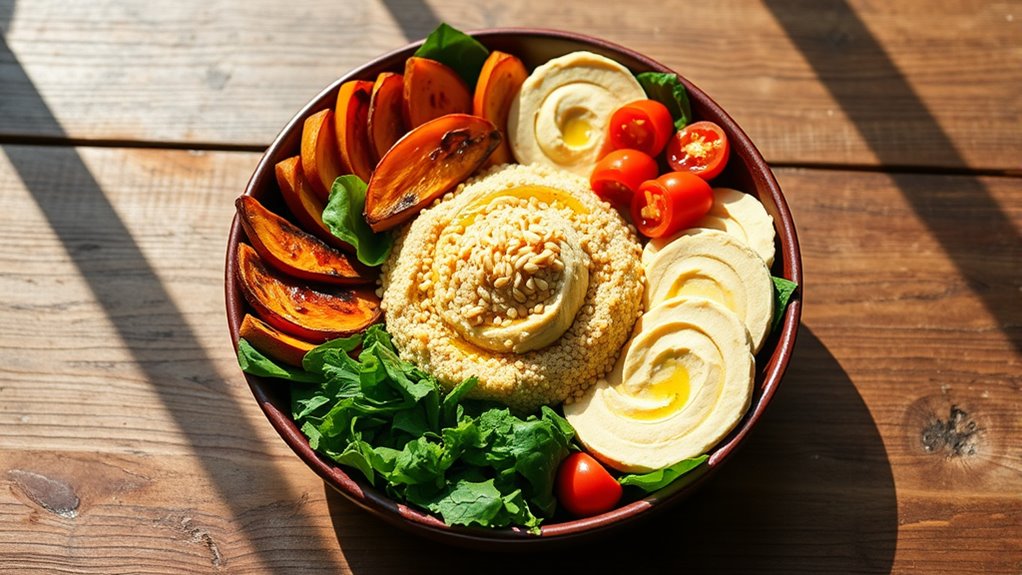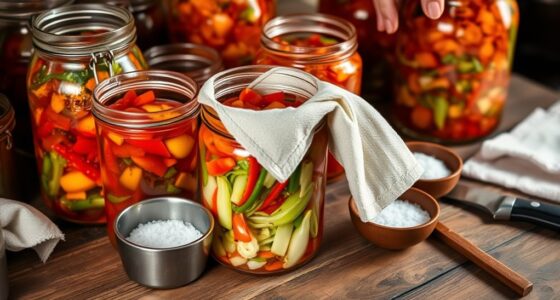To build a balanced Buddha bowl every time, start with a sturdy base like grains or greens, then layer in lean proteins such as chickpeas or grilled chicken. Add colorful vegetables, healthy fats like avocado or nuts, and season with herbs or spices for flavor. Aim for a mix of textures and flavors, balancing complex carbs, proteins, and fats to fuel, recover, or energize as needed. Keep experimenting with ingredients; the right combination guarantees a nourishing, satisfying meal.
Key Takeaways
- Start with a sturdy base of grains or greens to provide a foundation for the bowl.
- Incorporate a variety of colorful, nutrient-rich ingredients for balanced vitamins and minerals.
- Add lean proteins and healthy fats to support muscle repair and nutrient absorption.
- Use contrasting flavors and textures, like crunchy vegetables and creamy dressings, for satisfying mouthfeel.
- Season each component thoughtfully and control portions to maintain dietary balance and prevent excess.

A balanced Buddha bowl combines a variety of nutrient-rich ingredients in one satisfying dish, making it both healthy and visually appealing. To build one successfully, you need to think about nutrient timing and flavor combinations. Nutrient timing is essential because you want to include ingredients that fuel your body, support recovery, or boost energy at the right moments. For example, loading up on complex carbs like sweet potatoes or quinoa provides sustained energy, while lean proteins such as chickpeas or grilled chicken help with muscle repair after activity. Including healthy fats like avocado or nuts not only adds richness but also aids in the absorption of fat-soluble vitamins. Balancing these elements ensures your bowl delivers the nutrients you need, when you need them, optimizing your health and performance.
A balanced Buddha bowl combines nutrient-rich ingredients to fuel, recover, and energize your body effectively.
Next, focus on creating flavor combinations that excite your palate. A well-balanced bowl doesn’t have to be bland; instead, it should have a harmony of tastes and textures. Think about contrasting flavors—sweet with savory, crunchy with creamy, tangy with earthy. For example, pairing roasted sweet potatoes with tangy pickled vegetables or adding a drizzle of tahini over roasted chickpeas creates a delightful mix of flavors. Incorporate herbs and spices like cilantro, cumin, or lemon juice to elevate the taste. When arranging your ingredients, consider visual appeal as well, layering colors and textures to make the dish inviting. A vibrant bowl with contrasting colors and varied textures keeps you interested and encourages you to enjoy every bite.
In terms of building the bowl, start with a sturdy base—grain, greens, or both—and layer your protein, vegetables, and toppings thoughtfully. Aim for a variety of colors and textures to make each bite interesting and to maximize nutrient intake. Don’t forget to season each component properly; seasoning boosts flavor without adding unnecessary calories. A well-seasoned bowl is more satisfying and helps you stick to your healthy eating goals. Additionally, using healthy cooking methods such as roasting, steaming, or sautéing preserves nutrient content and enhances flavor.
Lastly, be mindful of portion sizes and balance. While it’s tempting to overload on favorite ingredients, moderation guarantees you get all the nutrients without excess calories. Keep an eye on your overall intake and tailor your ingredients based on your activity level and dietary needs. By paying attention to nutrient timing and flavor combinations, you’ll create Buddha bowls that are not only nourishing but also exciting to eat every time. The key is to plan thoughtfully, experiment with flavors, and enjoy the process of building a dish that’s as pleasing to the eye as it is to your body.
Frequently Asked Questions
Can I Prepare a Buddha Bowl Ahead of Time?
Yes, you can prep a Buddha bowl ahead of time. Use smart meal prep strategies by assembling ingredients in separate containers to keep everything fresh. Store components like grains, proteins, and veggies in airtight containers, following storage tips for maximum freshness. When you’re ready to eat, just reassemble or add fresh toppings. This approach saves time, reduces waste, and guarantees a healthy, balanced meal is always ready to enjoy.
What Are Some Vegan Protein Options for Buddha Bowls?
When choosing vegan sources for your Buddha bowl, you can explore a variety of plant-based proteins. Lentils, chickpeas, and black beans are excellent options that provide hearty, satisfying protein. Tofu and tempeh are versatile, high-protein vegan sources that absorb flavors well. Edamame offers a fresh, protein-rich addition. Incorporate nuts and seeds like chia or hemp for extra plant-based proteins, making your bowl both nutritious and delicious.
How Do I Add Flavor Without Excess Salt?
Think of your Buddha bowl as a blank canvas, waiting for vibrant colors. To add flavor without excess salt, explore seasoning alternatives like fresh herbs, spices, and citrus zest. These flavor enhancers brighten each bite, transforming your dish into a symphony of taste. By experimenting with garlic, cumin, or a splash of vinegar, you create depth without the need for heavy salt, making your bowl both delicious and healthful.
Are There Gluten-Free Grains Suitable for Buddha Bowls?
You can easily find gluten-free grains suitable for your Buddha bowls by exploring various grain alternatives. Quinoa, brown rice, millet, and buckwheat are excellent options that add texture and nutrition. These gluten-free grains not only diversify your bowl but also keep it safe for those with gluten sensitivities. Incorporate them as the base or a hearty topping to make your Buddha bowl both delicious and nutritious.
How Can I Customize My Buddha Bowl for Different Diets?
To customize your Buddha bowl for different diets, start with versatile ingredients and adapt based on your nutritional needs. Use meal prep techniques to prepare various proteins, grains, and vegetables ahead of time, making customization easier. Enhance flavor with herbs, spices, or dressings tailored to your diet. Whether gluten-free, vegan, or low-carb, this approach guarantees your bowl remains delicious and nutritious, fitting your specific dietary preferences every time.
Conclusion
Now that you know how to build a balanced Buddha bowl, you’re armed with a recipe for a nourishing masterpiece. Think of it as a symphony of flavors and nutrients working in harmony, each ingredient playing its part. When you assemble your bowl with intention, you’re not just feeding your body—you’re fueling your soul. So go ahead, create with confidence, and let every bite be a beacon of health and happiness on your plate.







